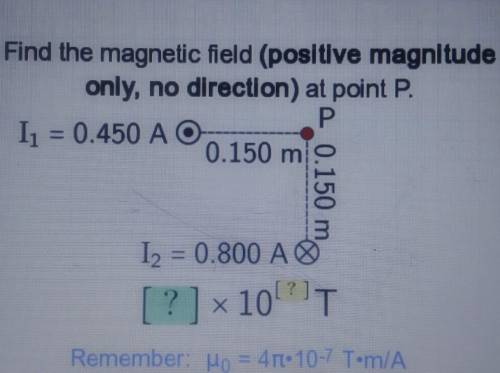
Physics, 18.08.2021 20:00 lanakay2006
Find the magnetic field (positive magnitude only, no direction) at point P. P I1 = 0.450 AO 0.150 m 0.150 m I2 = 0.800 A [?] x 10!?!


Answers: 1


Another question on Physics

Physics, 21.06.2019 20:00
You notice a very one-dimensional-thinking snail crawling along one rail of a railroad track. naturally, you remove it to a safer place. but before you do, you observe it as it moves from position xi = -92.9 cm to position xf = -64.9 cm along the rail, as measured from a point where one rail abuts the next. what is the snail\'s displacement δx in centimeters?
Answers: 1

Physics, 22.06.2019 18:30
Aballoon is rising vertically upwards at a velocity of 10m/s. when it is at a height of 45m from the ground, a parachute bails out from it. after 3s he opens his parachute and decelerates ata a constant rate 5m/s.when. (a) what was the height of the parachutist above the ground when he opened his parachute? (b)how far is the parachutist from the balloon at t=3s? (c)with what velocity does the parachutist hit the ground? (d)after how long does the parachutist hit the ground after his exist from the balloon?
Answers: 3

Physics, 22.06.2019 19:40
It may seem strange that the selected velocity does not depend on either the mass or the charge of the particle. (for example, would the velocity of a neutral particle be selected by passage through this device? ) the explanation of this is that the mass and the charge control the resolution of the device--particles with the wrong velocity will be accelerated away from the straight line and will not pass through the exit slit. if the acceleration depends strongly on the velocity, then particles with just slightly wrong velocities will feel a substantial transverse acceleration and will not exit the selector. because the acc
Answers: 1

Physics, 22.06.2019 20:30
Suppose a force of 60 n is required to stretch and hold a spring 0.1 m from its equilibrium position. a. assuming the spring obeys hooke's law, find the spring constant k. b. how much work is required to compress the spring 0.5 m from its equilibrium position? c. how much work is required to stretch the spring 0.6 m from its equilibrium position? d. how much additional work is required to stretch the spring 0.1 m if it has already been stretched 0.1 m from its equilibrium? a. kequals 600
Answers: 2
You know the right answer?
Find the magnetic field (positive magnitude only, no direction) at point P. P I1 = 0.450 AO 0.150 m...
Questions





English, 29.03.2021 02:00

History, 29.03.2021 02:00

Mathematics, 29.03.2021 02:00


English, 29.03.2021 02:00

Biology, 29.03.2021 02:00









Social Studies, 29.03.2021 02:00



